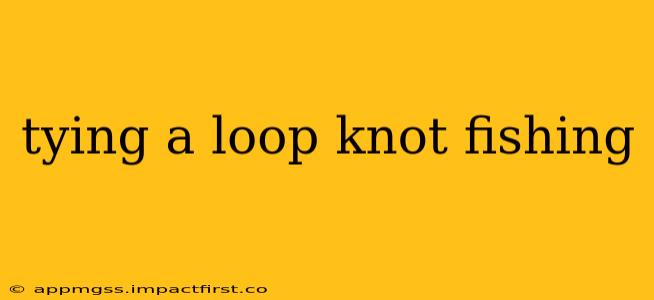The loop knot is a staple in fly fishing and increasingly popular among anglers using other techniques. Its ability to create a strong, snag-free connection between your line and leader, or leader and fly, makes it a valuable knot to master. This guide will walk you through tying the loop knot, addressing common questions and offering tips for success.
What is a Loop Knot Used For in Fishing?
The loop knot's primary function is to create a loop at the end of your fishing line or leader. This loop allows you to easily attach your fly or lure without the bulk of a traditional knot, enhancing casting distance and reducing snags. It's particularly beneficial in situations where delicate presentations are crucial, such as in fly fishing for wary trout.
How to Tie a Loop Knot (Step-by-Step Instructions)
While there are variations, the most common and reliable method involves these steps:
-
Create the Initial Loop: Hold your line (leader or tippet) and form a loop of the desired size, typically 1-2 inches. The size of the loop will depend on the size of your fly or lure.
-
Wrap the Line: Wrap the tag end of the line around the standing line, forming a neat loop. The number of wraps varies based on the diameter of your line, typically 4-6 wraps for finer lines and fewer for thicker lines. Aim for even spacing between wraps.
-
Form the Knot: After the wraps, pass the tag end of the line through the loop you initially created.
-
Tighten the Knot: Carefully pull both ends of the line to tighten the knot. Do this slowly and evenly to avoid breaking the line. Ensure the knot is seated firmly against the standing line.
-
Trim the Tag End: Trim the excess tag end of the line close to the knot, leaving just a small amount.
What are the Different Types of Loop Knots?
While the above method describes a basic loop knot, variations exist, each offering slight advantages depending on the line material and fishing conditions. Some anglers prefer using a different knot for fly fishing versus other fishing techniques. Research different knot styles to find the best fit for your needs. Remember, practice makes perfect when it comes to knot tying.
What is the Strongest Loop Knot for Fishing Line?
The strength of any knot is highly dependent on the execution. Tying a loop knot correctly is paramount. While no single loop knot universally reigns supreme, many anglers find the improved clinch knot, non-slip loop knot, and the surgeon's loop quite strong and reliable. Properly tying any of these reduces the chance of failure.
How to Improve My Loop Knot Tying Skills?
Practice! The key to tying a reliable loop knot is practice. Start with thicker lines to get a feel for the knot and then progress to finer lines. Use a knot tying board or a friend for assistance in perfecting your technique.
How Long Does a Properly Tied Loop Knot Last?
A properly tied loop knot should last throughout the duration of a fishing trip, provided there are no excessive abrasions. Regular inspection is always recommended.
Conclusion
The loop knot is a versatile and powerful tool in an angler's arsenal. Mastering this knot significantly improves your fishing experience by providing a cleaner, stronger, and more efficient connection between your line and your fly or lure. By understanding the steps and variations, you can confidently use this knot to enhance your angling success. Remember to practice frequently to ensure reliable and strong knot tying.
